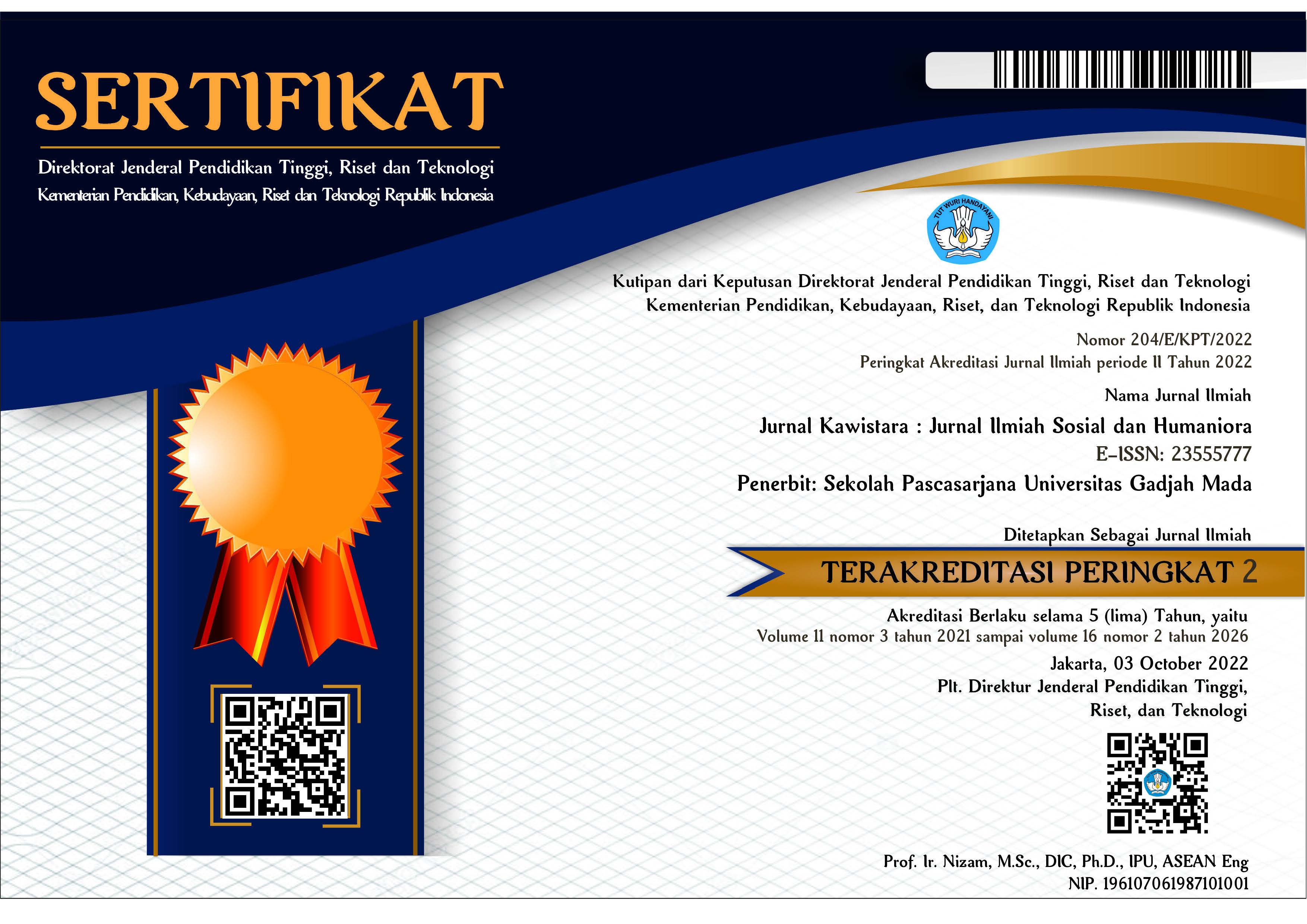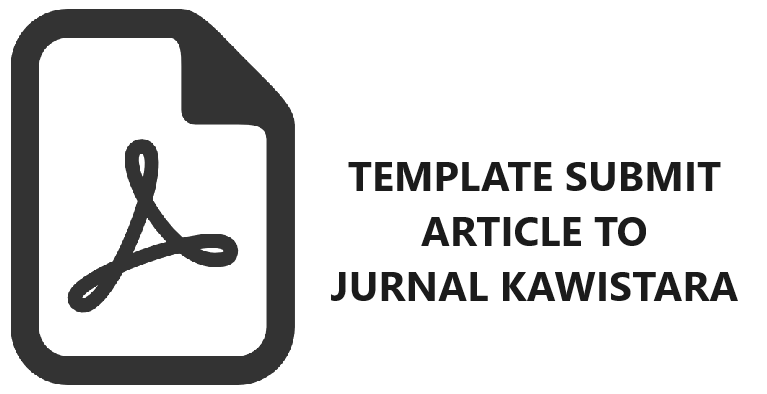The Indigenous Politics of Justice: the Case of the Sedulur Sikep Movement in Central Java
Ronald Adam(1*), Zainal Abidin Bagir(2)
(1) Center for Religious and Cross-Cultural Studies, Universitas Gadjah Mada, Yogyakarta
(2) Center for Religious and Cross-Cultural Studies, Universitas Gadjah Mada, Yogyakarta
(*) Corresponding Author
Abstract
The struggle by indigenous people to protect their land from capitalist expansion is often reduced by scholars to two contrasting models: class politics and identity politics. This reduction has partially come from how scholars separate between the cultural/spiritual and the political-economic dimensions of these struggles, which are often more complex in reality. Based on an empirical study of the Sedulur Sikep movement in Pati, Central Java, the purpose of this article is to understand what the indigenous politics of justice looks like in practice as they defend their land and way of life against the cement mining industry. This study uses a qualitative approach combining four months of field observations with two Wong Sikep households and interviews with 20 Wong Sikep individuals from 15 households in Baturejo Sukolilo Village, Pati Regency, Central Java. This article discusses two findings from the study. First, the cultural/spiritual and political-economic dimensions are inseparable in the lives of Wong Sikep. Such inseparability is manifested through the agricultural system as the core of Wong Sikep life, derived from the teachings of their ancestors (culture/spirituality) as well as their practical needs (political economy). Second, this inseparability forms the basis of their adoption of both the politics of recognition and redistribution in their resistance to cement mining. The article concludes with recommendations for future studies about the Sedulur Sikep movement in particular and for indigenous justice movements more broadly.
Keywords
Full Text:
PDFReferences
Acciaioli, G. (2007). From Customary Law to Indigenous Sovereignty: Reconceptualizing Masyarakat Adat in Contemporary Indonesia. In The Revival of Tradition in Indonesian Politics: The Development of Adat from Colonialism to Indigenism (pp. 295–381). Routledge.
Alamsyah, A. (2015). Eksistensi dan Nilai-Nilai Kearifan Komunitas Samin di Kudus dan Pati. Humanika, 21(1), 63–74. https://doi. org/10.14710/humanika.21.1.63-74.
Amin, A. A. (2018). A Resistance for Protecting Indigenous Rights: The Case Study of the Samin Community in Sukolilo Village, Pati, ndonesia. Journal of Human Rights and Peace Studies, 4(2), 223–254.
Andolina, R. (2003). The Sovereign and its Shadow: Constituent Assembly and Indigenous Movement in Ecuador. Journal of Latin American Studies,35(4), 721–750. https://doi.org/10.1017/S0022216X03006965.
Aprianto, T. C. (2013). Perampasan Tanah dan Konflik: Kisah Perlawanan Sedulur Sikep. Jurnal Bhumi, 157–168.
Asrawijaya, E. (2020). Gerakan Ekopopulisme Komunitas Samin Melawan Perusahaan Semen di Pegunungan Kendeng. Jurnal Sosiologi Pendidikan Humanis, 5(1), 35–47.
Asrawijaya, E., & Hudayana, B. (2021).The Power of a Leader in the Samin People’s Opposition Movement to the Development of a Cement Factory in the North Kendeng Mountains. Jurnal Humaniora, 33(1), 26. https://doi.org/10.22146/jh.56224.
Bagir, Z., Dwipayana, A. G., Rahayu, M.,Sutanto, T., & Wajidi, F. (2011). Pluralisme Kewargaan: Arah Baru Politik Keragaman di Indonesia. Mizan.
Baird, I. G. (2011). Turning Land into Capital,Turning People into Labour: Primitive Accumulation and the Arrival of Large-Scale conomic Land Concessions in the Lao People’s Democratic Republic. New Proposals: Journal of Marxism and Interdisciplinary Inquiry, 5(1), 10–26.
Banks, G. (2002). Mining and the Environment in Melanesia: Contemporary Debates Reviewed. The Contemporary Pacific, 14(1), 39–67. https://doi.org/10.1353/cp.2002.0002.
Bebbington, A. (1996). Movements, Modernizations, and Markets. In Liberation Ecologies: Environment,Development, Social Movements (pp. 86–109). Routledge.
Bebbington, A. (2012a). Social Conflict,Economic Development and Extractive Industry: Evidence from South America. Routledge.
Bebbington, A. (2012b). Social Conflict, Economic Development and Extractive Industry: Evidence from South America. 140. Benda, H. J. (1965). Peasant Movements in Colonial SoutheastAsia. Southeast Asia Studies, 420–434.
Benda, H. J., & Castles, L. (1969). The Samin movement. Bijdragen Tot de Taal-, Land- En Volkenkunde / Journal of the Humanities and Social Sciences of Southeast Asia, 125(2), 207–240. https://doi.org/10.1163/22134379-90002844.
Borras Jr, S. M., & Franco, J. C. (2012). Global Land Grabbing and Trajectories of Agrarian Change: A Preliminary Analysis: Global Land Grabbing and Trajectories of Agrarian Change. Journal of Agrarian Change, 12(1), 34–59. https://doi.org/10.1111/j.1471-366.2011.00339.x.
Christina, M. (2012). Recognition of Indigenous Peoples in Indonesia: An International
Human Rights Law Approach. University of Tilburg.
Collins, R. B. (2003). Sacred Sites and Religious Freedom on Government Land.Journal of Constitutional Law, 241–270.
Conde, M. (2017). Resistance to Mining. A Review. Ecological Economics, 132, 80–90. https://doi.org/10.1016/j. ecolecon.2016.08.025
Conde, M., & Le Billon, P. (2017). Why do some communities resist mining projects while
others do not? The Extractive Industries and Society, 4(3), 681–697. https://doi.org/10.1016/j.exis.2017.04.009.
Fraser, N. (1997). Justice interruptus: Critical reflections on the “postsocialist” condition.
Routledge.
Fraser, N. (1998). Social justice in the age of identity politics. Redistribution,recognition, participation.Wissenschaftszentrum Berlin Für Sozialforschung (WZB), 98–108.
Fraser, N. (2000). Rethinking Recognition. New Left Review, 107–120.
Fraser, N. (2003). Social Justice in the Age of Identity Politics: Redistribution,Recognition, and Participation. In Redistribution or Recognition? A Political-Philosophical Exchange (pp. 7–109). Verso.
Fraser, N., & Honneth, A. (2003). Redistribution or recognition? A political-philosophical
exchange. Verso.
Giap, T. S. (1968). The Samin and Samat Movements in Java: Two Examples. Revue
Du Sud-Est Asiatique et de l’Extreme Oriënt, 107–113.
Giap, T. S. (1969). The Samin Movement in Java: Complementary Remarks. Revue Du
Sud-Est Asiatique et de l’Extreme Oriënt,63–77.
Gilbert, J. (2006). Indigenous peoples’land rights under international law:From victims to actors. Transnational Publishers.
Gilbert, J. (2015). Land grabbing, investors, and indigenous peoples: New legal
strategies for an old practice? Community Development Journal, 51(3), 1–17. https://doi.org/10.1093/cdj/bsv025.
Haarstad, H., & Fløysand, A. (2007).Globalization and the Power of Rescaled
Narratives: A Case of Opposition to Mining in Tambogrande, Peru. Political
Geography, 26(3), 289–308. https://doi. org/10.1016/j.polgeo.2006.10.014.
Holden, W., Nadeau, K., & Jacobson, R. D.(2011). Exemplifying accumulation by
dispossession: Mining and indigenous peoples in the philippines. Geografiska
Annaler: Series B, Human Geography,93(2), 141–161. https://doi.org/10.1111/j.1468-0467.2011.00366.x.
Horowitz, L. (2002). Daily, Immediate Conflicts: An Analysis of Villagers’Arguments about a Multinational Nickel Mining Project in New Caledonia1. Oceania, 73(1), 35–55. https://doi.
org/10.1002/j.1834-4461.2002.tb02805.x.
Horowitz, L. S. (2010). “Twenty Years Is Yesterday”: Science, Multinational Mining, and the Political Ecology of Trust in New Caledonia. Geoforum, 41(4), 617–626. https://doi.org/10.1016/j.geoforum.2010.02.003.
Hufe, P., & Heuermann, D. F. (2017). The local impacts of large-scale land acquisitions:
A review of case study evidence from Sub-Saharan Africa. Journal of Contemporary African Studies, 35(2), 168–189. https://doi.org/10.1080/02589001.2017.1307505.
Hvalkof, S. (2008). Privatization of Land and Indigenous Communities in Latin America:Tenure Security or Social Security? (pp. 1–22).
King, V. T. (1973). Some observations on the Samin movement of North-Central Java.
Suggestions for the theoretical analysis of the dynamics of rural unrest. Bijdragen
Tot de Taal-, Land- En Volkenkunde/Journal of the Humanities and Social Sciences of Southeast Asia, 129(4), 457–481. https://doi.org/10.1163/22134379-90002714.
King, V. T. (1977). Status, economic determinism and monocausality: More on the Samin. Bijdragen Tot de Taal—,Land-En Volkenkunde/Journal of the Humanities and Social Sciences of
Southeast Asia, 133(2), 350–354. https://doi.org/10.1163/22134379-90002617.
Korver, A. P. E. (1976). The Samin movement and millenarism. Bijdragen Tot de Taal-
, Land- En Volkenkunde / Journal of the Humanities and Social Sciences of Southeast Asia, 132(2), 249–266. https://doi.org/10.1163/22134379-90002642.
Kristianto, E. D. (2009). Menyelamatkan lingkungan berakhir di penjara:Kriminalisasi 9 warga penolak pabrik semen di Kabupaten Pati. YLBHI, Lembaga Bantuan Hukum Semarang.
Kroef, J. M. van der. (1952). The Messiah in Indonesia and Melanesia. The Scientific Monthly, 75(3), 161–165.
Kroef, J. M. van der. (1959). Javanese Messianic Expectations: Their Origin and Cultural
Context. Comparative Studies in Society and History, 1(4), 299–323. https://doi. org/10.1017/S0010417500000347.
Kurniawan, J. A. (2014). Contested Land, Contesting Laws. A Context of Legal
Pluralism and Industrialization in Indonesia. Sortuz: Oñati Journal of Emergent Socio-Legal Studies, 6(2), 93–106.
Kurniawan, J. A. (2018). Pelajaran dari Konflik Antara Komunitas Sedulur Sikep dan
Industri Semen di Jawa Tengah. Mimbar Hukum - Fakultas Hukum Universitas Gadjah Mada, 30(3), 504. https://doi.org/10.22146/jmh.37985.
Maarif, S. (2017). Pasang Surut Rekognisi Agama Leluhur Dalam Politik Agama di Indonesia.
Martinez-Alier, J., & O’Connor, M. (1996).Ecological and Economic Distribution Conflicts. In Getting down to Earth:Practical Applications of Ecological Economics. Island Press.
Mkodzongi, G. (2013). New People, New Land and New Livelihoods: A Microstudy of Zimbabwe’s Fast-track Land Reform. Agrarian South: Journal of Political Economy: A Triannual Journal of Agrarian South Network and CARES, 2(3), 345–366. https://doi.org/10.1177/2277976013517320.
Moniaga, S. (2007). From Bumiputera to Masyarakat Adat: A Long and Confusing Journey. In The Revival of Tradition in Indonesian Politics: The Development of Adat from Colonialism to Indigenism (pp.275–294).
Murtadho, R. (2016). Agama dan Krisis Ekologi:Ketidakmampuan Para Tokoh dan Kiai Melawan Dosa Semen di Rembang Jawa Tengah. 05(02), 16.
Northcott, M. S. (2015). Place, ecology and the sacred: The moral geography of sustainable communities. Bloomsbury.
Novianto, A. (2018). Berebut Saminisme:Artikulasi Politik Masyarakat Adat dalam
Konflik Pembangunan Pabrik Semen di Pegunungan Kendeng. In Kebijakan Publik dalam Pusaran Perubahan Ideologi (pp. 228–252). Gadjah Mada University Press.
Pacheco, A. J. (2017). Primitive Accumulation in Indigenous Mexico: The Contested Transformations of the Maya “solar” of Yucatán. City, 21(3–4), 503–519. https://
doi.org/10.1080/13604813.2017.1335476.
Padel, F., & Das, S. (2010). Cultural Genocide and the Rhetoric of Sustainable Mining in East India. Contemporary South Asia,18(3), 333–341. https://doi.org/10.1080/09584935.2010.503871.
Paramita, R. P., & Islahuddin. (2017). Ekosistem kawasan karst tak tergantikan. Lokadata.
https://lokadata.id/artikel/ekosistemkawasan-karst-tak-tergantikan.
Pratiwi, A. M. (2017). Kembalikan Kedaulatan Ruang Hidup dan Ekologi Masyarakat
Kendeng Utara. Jurnal Perempuan.ht t p : //www. j u r n a l p e rempuan.
org/8/post/2017/04/-kembalikankedaulatan-ruang-hidup-dan-ekologimasyarakat-
kendeng-utara.html.
Prause, L., & Billon, P. L. (2020). Struggles for land: Comparing resistance movements against agro-industrial and mining investment projects. The Journal of Peasant Studies, 1–24. https://doi.org/10. 1080/03066150.2020.1762181.
Putri, P. S. (2017). The Meaning Making of an Environmental Movement: A Perspective
on Sedulur Sikep’s Narrative in Anti-Cement Movement. Power Conflict Democracy Journal, 5(2), 297–321.
Rumsey, A., & Weiner, J. (2004). Mining and Indigenous Lifeworlds in Australia
and Papua New Guinea. Sean Kingston Publication.
Sangaji, A. (2007). The Masyarakat Adat Movement in Indonesia: A Critical Insider’s View. In The Revival of Tradition in Indonesian Politics: The Development of Adat from Colonialism to Indigenism (pp. 319–336). Routledge.
Schippers, T. (2010). Securing Land Rights through Indigenousness: A Case from the Philippine Cordillera Highlands. Asian Journal of Social Science, 38(2), 220–238. https://doi.org/10.1163/156853110X490917.
Scott, J. C. (1977a). Protest and Profanation:Agrarian Revolt and the Little Tradition, Part I. Theory and Society, 4(1), 1–38.
Scott, J. C. (1977b). Protest and Profanation:Agrarian Revolt and the Little Tradition,Part II. Theory and Society, 4(2), 211–246.
Shiraishi, T. (1990). Dangir’s Testimony:Saminism Reconsidered. Indonesia, 50,95. https://doi.org/10.2307/3351232.
Silva-Macher, J. C., & Farrell, K. N. (2014). The Flow/Fund Model of Conga: Exploring
the Anatomy of Environmental Conflicts at the Andes-Amazon Commodity Frontier. Environment, Development and Sustainability, 16(3), 747–768. https://doi. org/10.1007/s10668-013-9488-3.
Subekti, T. (2016a). Konflik Samin vs PT.Semen Indonesia. Jurnal Transformative,2(2), 189–202.
Subekti, T. (2016b). Konflik Samin vs PT.Semen Indonesia. 2, 14.
Trope, J. F. (1991). Protecting Native American Sacred Sites and Religious Freedom. Wicazo Sa Review, 7(2), 53. https://doi.org/10.2307/1409063.
Urkidi, L. (2011). The Defence of Community in the Anti-Mining Movement of Guatemala: Defence of Community in the Anti-Mining Movement of Guatemala. Journal of Agrarian Change, 11(4), 556–580. https://doi.org/10.1111/j.1471-0366.2011.00326.x.
Vinueza, J. A. (2005). The Ecuadorian Indigenous Movement and the Gutierrez regime. PoLAR: Political and Legal Anthropology Review, 28(1), 93– 111. https://doi.org/10.1525/pol.2005.28.1.93.
Walter, M., & Martinez-Alier, J. (2010). How to Be Heard When Nobody Wants to Listen: Community Action against Mining in Argentina. Canadian Journal of Development Studies /Revue Canadienne d’études Du Développement, 30(1–2), 281–301. https://doi.org/10.1080/02255189.2010.9669292.
White, B., Borras Jr., S. M., Hall, R., Scoones, I.,& Wolford, W. (2012). The new enclosures:
Critical perspectives on corporate land deals. The Journal of Peasant Studies, 39(3–4), 619–647. https://doi.org/10.1080/03066150.2012.691879.
Whitehead, J. (2003). Space, Place and Primitive Accumulation in Narmada Valley and Beyond. Economic and Political Weekly, 38(40), 4224–4230.
Wibowo, A. (2011). Strategi Masyarakat Samin dalam Mempertahankan Keseimbangan
Ekologis. Berkala Penelitian Hayati, 35–42.
Widiyarsono, A. (1998). Gerakan Samin:Perlawanan Rakyat tanpa Kekerasan. UNISIA, 81–95.
Article Metrics
Refbacks
- There are currently no refbacks.
Copyright (c) 2022 Ronald Adam; Zainal Abidin Bagir

This work is licensed under a Creative Commons Attribution-ShareAlike 4.0 International License.
Jurnal Kawistara is published by the Graduate School, Universitas Gadjah Mada.











